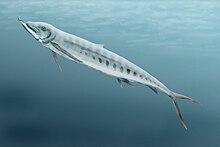Gwawinapterus
| Gwawinapterus | ||||||||||
|---|---|---|---|---|---|---|---|---|---|---|
| Temporal occurrence | ||||||||||
| Upper Chalk (Upper Campanium ) | ||||||||||
| 76.4 to 72 million years | ||||||||||
| Locations | ||||||||||
| Systematics | ||||||||||
|
||||||||||
| Scientific name | ||||||||||
| Gwawinapterus | ||||||||||
| Arbor & Currie , 2010 | ||||||||||
| Art | ||||||||||
Gwawinapterus ("winged raven") is a fossil genus from the Upper Cretaceous of Canada , which is based on a jaw fragment including teeth. The only species is Gwawinapterus beardi . The genus was established in 2010 andassigned tothe Istiodactylidae , a group of pterosaurs that may haveoccupieda similar ecological niche as today's vulturesas scavengers . This would make Gwawinapterus the first Istiodactylidae known from the Upper Cretaceous as well as the first tooth-bearing pterosaur known from the Upper Cretaceous. However, a study published in 2012 came to the conclusion that the fossil did not belong to a pterosaur, but to a bony fish from the group of the Saurodontidae .
The name Gwawinapterus is derived from Gwa'wina ("raven") from the language Kwak'wala , as well as from Pteron ("wing") from ancient Greek. Kwak'wala is spoken by the Kwakwaka'wakw , an Indian tribe of the northern Vancouver Islands. The second part of the species name, beardi , honors Graham Beard, the discoverer of the fossil.
Features and classification

The only fossil is within a calcite - concretion preserved and shows part of a jawbone. The fossil was revealed after the concretion was mechanically split in half. A large part of the bone material is found on one half, which has, however, been splintered in many places as a result of the splitting, while the corresponding imprints and other bone remnants are found on the counterplate. The jawbone is bad, but the teeth are well preserved.
In the first description by Victoria Arbor and Philip Currie, Gwawinapterus is assigned to the pterosaur family Istiodactylidae. Common features of the dental crowns indicate that they belong to this group : These are triangular, laterally (labiolingual) flattened and straight; there is no serration. As early as spring 2012, the pterosaur specialist Mark Witton had doubts about belonging to the pterosaurs: The change of teeth in all pterosaurs takes place when the replacement tooth breaks through behind the tooth to be replaced - the Gwawinapterus fossil, however, shows that the replacement teeth are directly below of the teeth to be replaced. Researchers led by Romain Vullo finally argue in autumn 2012 that dental features described not only for Istiodactyliden but also for saurodontide fish such Saurodon and Saurocephalus are typical. The jaw fragment shows at least 25 closely spaced teeth; this configuration is typical for saurodontid fish, but not for istiodactylids, which usually showed fewer than 15 teeth per half of the jaw, which were less densely packed. Vullo and colleagues interpreted the fossil as an incomplete isolated maxillary . The leading edge of the fossil would represent the suture separating the maxilla from the missing premaxillary .
Vullo and colleagues (2012) were unable to identify any unique features that could be used to distinguish the fossil from known saurodontid genera. Consequently, they declared the genus Gwawinapterus as the noun dubium (dubious name).
Fund and paleoenvironment
The fossil comes from Hornby Island , off Vancouver Island ( British Columbia , Canada). It was collected in the northwest of the island (Collishaw Point). Collishaw Point is considered to be an abundant site for fossil-bearing calcite concretions, known are finds of numerous plants, invertebrates, bony fish, sharks and mosasaurs . In 2005, the discovery of birds from the Ornithurae and Enantiornithes groups was also announced. Geologically, the site belongs to the Northumberland Formation , which is composed predominantly of dark gray silty pelites and coarser turbidite deposits, which were deposited in deeper water. Saurodontid fish such as Prosaurodon , Saurocephalus and Saurodon are widespread in the Upper Cretaceous North America.
Individual evidence
- ^ Mark P. Witton: Istiodactylidae. In: Mark P. Witton: Pterosaurs. Natural history, evolution, anatomy. Princeton University Press, Princeton NJ et al. 2013, ISBN 978-0-691-15061-1 , pp. 143-151.
- ↑ a b c d Victoria M. Arbour, Philip J. Currie : An istiodactylid pterosaur from the Upper Cretaceous Nanaimo Group, Hornby Island, British Columbia, Canada. In: Canadian Journal of Earth Sciences. Vol. 48, No. 1, 2011, ISSN 0008-4077 , pp. 63-69, doi : 10.1139 / E10-083 .
- ^ Mark P. Witton: New Insights into the Skull of Istiodactylus latidens (Ornithocheiroidea, Pterodactyloidea). In: PLoS ONE . Vol. 7, No. 3, 2012, e33170, doi : 10.1371 / journal.pone.0033170 .
- ↑ a b c Romain Vullo, Éric Buffetaut , Michael J. Everhart: Reappraisal of Gwawinapterus beardi from the Late Cretaceous of Canada: a saurodontid fish, not a pterosaur. In: Journal of Vertebrate Paleontology. Vol. 32, No. 5, 2012, ISSN 0272-4634 , pp. 1198-1201, doi : 10.1080 / 02724634.2012.681078 .